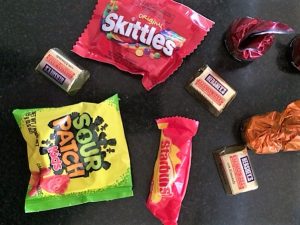We all know Halloween is not just about costumes, haunted forests and bobbing for apples – it’s the candy. Perfect timing to talk about sugar.
In August, the American Heart Association (AHA) came out with new recommendations to limit added sugar for children over the age of 2 to no more than 6 teaspoons (25 grams or 100 calories) of added sugar daily (Reference 1). That includes limiting sugar-sweetened drinks to 1 (8-ounce) beverage a week. Children under the age of two shouldn’t have any added sugar.
It’s not all about tooth decay, sugary foods displacing more nutritious foods in the diet and contributing excess calories that are linked to excess weight and obesity. The Heart Association cites research linking added sugars at levels below average consumption to increased risk of cardiovascular disease.
Adults aren’t spared. The AHA recommends that added sugar comprise no more than half of one’s “discretionary calories” *which for most American women is the same as the recommendation for children, 6 teaspoons, and for most men is 9 teaspoons (36 grams or 144 calories).
The 2015-2020 Dietary Guidelines for Americans (DGA / Reference 3) has a more liberal recommendation to limit added sugars to 10% of one’s calorie needs. That’s 200 calories for a 2,000-calorie diet. Even that is a challenge in our ultra-sweet world.The average American takes in 270 calories (13% of calories) or about 17 teaspoons daily (3). Children consume even more, an average of 19 teaspoons each day, mostly from soda and other sugary drinks, cakes and cookies (5).
Most people know that all the calories in soft drinks are from sugar – a 12-ounce soda contains about 9 ½ teaspoons of sugar (150 calories). But added sugar lurks in surprising places like salad dressing, condiments like sriracha (3 grams/tablespoon) ketchup (2 grams/tablespoon), and flavored yogurts, which can have up to about 35 grams of added sugar in an 8-ounce serving. Reading labels can help. Sugar in prepared barbecue sauces can range from 4 grams to 13 grams for a 2 -tablespoon serving.
Finding added sugar will be easier starting July 26, 2018 when the Nutrition Facts label on food products will be required to list the total sugar and the added sugars in a food.
Naturally-occurring sugars found in whole fruits and dairy products are not limited because the sugar is packaged with other key nutrients. An exception is fruit juice which the DGA and American Academy of Pediatrics both recommend limitations on (3,4).
The culture of candy for Halloween festivities is not going to change anytime soon. But if you want to be more selective about your candy intake this Halloween check out Cooking Light’s guide to popular candy, ranked from least to most sugar (6).
*Discretionary calories are extra calories “left over” after meeting all of one’s nutrient needs. They can be enjoyed as treats like desserts or soda, foods that provide calories but few or no nutrients (2).
References
1. American Heart Association Journals
2. FDA.gov
3. Dietary Guidelines for Americans
6. Cooking Light Smart Candy Choices
© Lorelle Del Matto 2016

 About lorelle
About lorelle
Speak Your Mind